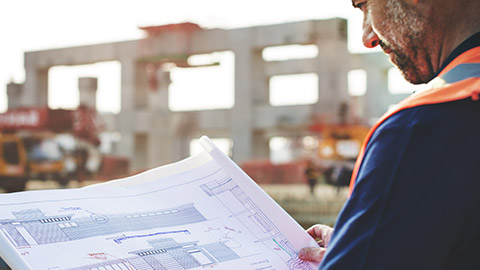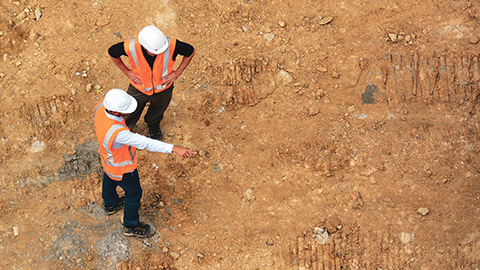Introduction
Welcome to this module of Construction Planning - Knowledge.
The learning outcome of this module is to design an on-site Commercial construction work programme.
In this topic of Documentations Required for Construction, we look at the key governing documents needed to complete the Commercial work programme.
Our aim in this topic is to:
- Identify the construction documentation and how compliance is ensured.
- Understand the application for the consent process.
Module 1 Introduction from Will
This is the first and most important stage of implementing positive construction management.
The principles and documents in this stage support the project until the end of the proposed work.
The success of a construction project depends on the following:
- the building design,
- the consent documentation and their related drawings and specifications, and
- the contracts.
Application documentation must include enough supporting information to show how your planned work will comply with the Building Code.
These collective documentations are essential for the:
- Building Code requirements
- weather tightness
- safety
- structural integrity of any commercial building.

Your building project locations and complexities vary. Projects could be:
- simple or complex
- a renovation or a completely new build
- based on the beach, a remote forest hillside, or anywhere else you could think of.
The location of your land and the position of your allocated construction site can greatly impact your actual project design, whether it's the set-up or the required implementation.
The size and complexity of the finished build can affect the duration and complexity of the actual building process.
You should follow the correct stages of the process to meet all the required standards and to meet its required working documents.
In general, whatever you are planning to build, you need to first think about all the necessary beginning stages; this could be:
- How is it going to sit?
- Do we have proof that the land is ours?
- How many specialist practitioners and contractors do I need?
- What materials and environmental factors need to be considered to accommodate and generate a successful build project?
These beginning stages need to be completed by the relevant parties before the construction of the foundations.
How do we achieve this?
Plans and specifications (plans and specs) for all building work must satisfy a number of different requirements. They communicate between all parties involved in a project, meaning the work can be accurately priced and estimated. It allows the work to be correctly constructed.
Plans and specs also:
- form part of the contractual agreement between the client and the contractors carrying out the work
- comply with the Building Code's functional and performance requirements for the building consent.
Remember, before any construction begins, the plans and specs documents need to be shown to and approved by the various bodies overseeing the work.
Working Drawings
Working drawings, another terminology for plans, are usually prepared by architects, designers, engineers, or people competent in preparing such detailed drawings.
In general, these drawings will clearly and accurately represent the extent and content of the project by:
- defining the work to be carried out
- materials to be used
- and the quality of work expected.
Within these documents are the 'working drawings', which show:
- the building's shape, size and position on a site,
- the composition of the materials used,
- how the building will be constructed or put together
- the bulk of the project's location to obtain resource planning consent, which is always required before or alongside a building consent application.
The information within these construction drawings has to be presented precisely and clearly so that anyone with knowledge of construction can understand it.
A range of people directly or indirectly connected with the project need access to the information in these working drawings. These groups could be vast, including everyone from your surveyors and the earthworks team carrying out the site cut to the flooring team.
Health and Safety: Site-Specific Safety Plans
Under the Health and Safety at Work Act, a person conducting a business or undertaking (PCBU), which includes company directors, need to have a clear and robust strategy on how the organisation will manage health and safety at work this is no more important than on a big commercial build project.
This comprehensive site-specific H&S plan is required to ensure the safety of workers and the public during the project construction stages.
As all build projects will be different, this plan should address your potential hazards, risk management strategies, and all relevant compliance factors associated with the New Zealand health and safety regulations.
The following link outlines Naylor Love’s Minimum HSE Requirements which sets out the standards that are expected by all their subcontractors and suppliers on sites: Section 7. Outlines the Site-Specific Safety Plan.
Other Governing Documents
- Record of Title/Certificate of Title gives the property's legal description and ownership history. Further reading on Record of Title available here.
- PIM - Project Information Memorandum is a report containing information about the land's special features and existing utility services on your property. Further reading on PIM is available here.
- LIM - Land Information Memorandum is a report prepared by a Territorial Authority (TA) about matters affecting the land and buildings on a particular property. Further reading on LIM available here.

Allocated parties will prepare drawings and specifications that will define the detailed requirements for the construction of the building, and these will be used during the construction process.
Consent Process
Regional authorities (local/district councils) have the following responsibilities;
- carry out regulatory building control,
- issue Building Consents and
- enforce the NZ Building Code and Building Performance Regulations.
The territorial authority administers the act and its regulations within their territorial boundaries.
Building Consent Authorities (BCA) Register are the local and district councils, but they can also be private organisations.
It is very useful to find out who you need to be in communication with within your local area before any project idea gets its momentum because each entity supplies useful information about local building policies, processes and regulations.
The government's building performance website (building.govt.nz) provides useful information on finding your local BCA.
Now you know who you need to communicate and liaise with, it is time to put your project application into the required consent process.
Just remember, the owner intending to carry out the building work is responsible for applying for the building consent and arranging their required inspections.
Still, these responsibilities are usually allocated to their main representative or contractor.
The Building Act clearly states that a person must not carry out building work except by building consent unless it is exempt. If building work is done without building consent, the owner commits an offence under the Building Act.
So, when applying for your building consent, you will need to:
- review your plans after getting advice from other parties
- review the proposed budget, as things can change
- decide whether you need to change your project. As this is the beginning stage, this is the best time to do it.
If, for some reason, you need to make variations or changes later, you will need to:
- apply to amend your consent, which would cost more money as well as potentially delay your project itself.
When you are applying for building consent and any other relevant needed permits, make sure:
- the person completing the application knows what to do and how to make a good application
- what supporting information needs to be accompanied.
In general, your consent application needs to include all the requested information from your TA or BCA, including your detailed drawings and evidence to show the project complies with the set Building Code.
From a client's perspective, they would always need to ensure they have a licensed building practitioner in connection with the building consent application. This will ensure the documents attached adhere to the required processes.
If the project requires any resource consent or other permits, they must apply for these before any block has been laid. These need to be approved.
Building Performance NZ states that "building consent will lapse if you don't start the building work within 12 months unless you have arranged an extension with your council".
Remember to give yourself and your team enough time to complete the project, as discussed with the client.
This graphic has been created from the New Plymouth District Council ‘Information about the building consent process’ fact sheet.
This basic image explains the 12-step process, including the design and construction, on a basic application, showing and generalising the information required to comply with the building code in the New Plymouth area.
- Get your ideas together: talk with a licensed builder practitioner (LBP), an architect or a designer to do some preliminary designs.
- Get a property information memorandum (PIM): a PIM tells you about the land and if you need a resource consent or any other application.
- Finalise your design: LBP (the designer) or you - under the owner-builder exemption - design the restricted building work (RBW). If you are using the owner-builder exemption you need to complete a statutory declaration as to owner-builder status.
- Apply for a building consent: submit all supporting documentation, including a certificate of design work, and include the names of all LBPs who will be doing or supervising the RBW (if known).
- Receive decision: you will receive a decision on your building consent application within 20 working days. During this period, we may request further information to confirm that the work complies with the Building Code.
- Pay your fees: after paying fees, your building consent will be issued.
- Begin construction: make sure that the names of the LBPs involved in the initial construction phase have been provided to us and that the others are identified before their part of the work begins. Also, notify us if there is a change in owner-builder status or if an LBP leaves the project and is replaced.
- Book in your inspection: an inspection booking for restricted building work will only be accepted if you have provided the names of the LBPs who have done the work and/or the declaration as owner-builder. Make sure that you have notified us of who will be doing the restricted building work.
- Receive inspection result: an NPDC building inspector will inspect the work and check on who the owner-builder/LBPs are that are doing the restricted building work. LBPs and owner-builders must fulfil restricted building work requirements. If they fail to do so, NPDC has the authority to stop the work by issuing a warning or a notice to fix.
- Application for Code Compliance Certificate (CCC): As soon as practicable after all of the building work to be carried out as part of the building consent has been completed, apply for a CCC. The completed application for CCC must be accompanied by energy certificates and records of work for all or any LBPs.
- Final inspection: all building consents require a final inspection to confirm that the work carried out is in accordance with the approved plans and complies with the Building Code for a residence.
- Issue CCC: you will receive a decision on your application for a CCC within 20 working days. A CCC is an important document you should pursue as quickly as possible. It confirms that all work complies with the relevant safety and building standards - important for your insurer and if you want to sell your property in the future!
On a final note, remember all building work requires building consent unless it is classed as 'exempt work". You can find support and guidance on exempt work from the government's building performance website "Check if it needs consent". Or by reading Schedule 1 of the Building Act.
Read this for more information.
You cannot start physical work on your building project until you have the building consent. Be aware that building consent will lapse if the work does not commence within 12 months of the issuing of the consent.
Certificate of Public Use (CPU)
"If you want to let the public use the building before a code compliance certificate has been issued, you must apply for a Certificate for Public Use".
Section 363 of the Building Act relates specifically to building premises that have an attended use, like schools, shops, hospitals, or restaurants that have to carry on operating.
Sections 363 (3-4) states that allowing a building to be occupied or open to the public without a CCC or CPU is an offence with a maximum fine of $200,000.
The TA issues this type of Certificate, and it must be obtained if certain parts of the building are to be occupied before the completed issuing of the Code of Compliance certificate.
Referenced from the Auckland council website, "A CPU may be applied for at the same time as the building consent if the proposed work involves alterations or additions to an existing building and this work affects public access to the premises. Work cannot commence until a CPU is in place".
A CPU doesn’t apply for private homes, apartment buildings, or if the building work doesn't require building consent, such as a non-structural fit-out of a shop or office (as stated by the government's building performance website).
Building Warrant of Fitness
Building Warrant of Fitness (BWOF) is like a car Warrant of Fitness.
It is an annual certificate or statement that proves and confirms that the systems specified in recommended compliance scheduling for the building have been maintained and checked and will continue to perform as required.
Your council issues your Compliance Schedule.
It lists the inspection, maintenance, and reporting procedures for certain systems and features in the building, like your lifts, fire alarms or air conditions.
Notice to fix
Building Performance NZ states that a notice to fix is a statutory notice requiring a person to remedy a breach of the Building Act 2004 or any of the Regulations under this act.
This notice to fix from the council can be issued for all breaches of the act, not just for the building work. A notice to fix can state that all or any building work must cease immediately.
Some examples of where a notice to fix could be issued:
- would be carrying out building work without building consent
- doing work not granted by the building consent
- or even changing the use of a building without notifying the council.
Code of Compliance Certificate
The Code of Compliance certificate is a final sign-off by a government entity to say that the building has been completed and complies with all the requirements of the Building Code.
Let's have a recap of the documentation governing the consent process.
